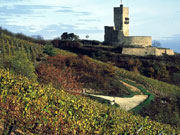Alsace’s cuisine marries food and wine

Gourmet cuisine
Food and wine in the Alsace region of France that borders the River Rhine are like love and marriage: they complement each other. Separation, according to locals, is almost unthinkable.
“In Alsace, it’s very important that there is a good marriage between food and wine, and children are taught from an early age to appreciate this,” enthuses Yvelise Sciard, from the House of Alsace Wines.
“People on the street correctly suggest sauerkraut as a typical Alsatian dish, but they mistakenly name Gewürztraminer as the wine best suited to accompany it.
“Gewürztraminer is too aromatic, and of course you must drink Riesling [which is sweeter] with sauerkraut.”
A visit to the House of Alsace Wines in Colmar – which offers lessons on this very issue – might help avoid such mistakes when ordering a meal in an Alsatian restaurant.
Perhaps the best advice to a naive customer is to allow the chef to choose the wine he thinks best.
Patrick Fulgraff, head chef at the “Au Fer Rouge” restaurant in Colmar’s old town, proposed that I drink a Tokay Pinot Gris to accompany a fish dish of roasted duck foie gras and lobster (complete with balsamic dressing). The result was a symphony of different tastes.
“Alsace has its own gastronomic heritage and over the past decade chefs have been adapting and inventing new recipes,” he says.
Fulgraff is the third generation of gourmet chefs in his family and describes his cuisine as “simple, tasty and seasonal”.
A Pinot Noir was selected as the next wine to offset a dish of turbot, shallots and haricot beans in a red wine sauce. A hint of cinnamon was the secret ingredient that took the culinary experience to another dimension.
Knowing a slice of Alsace’s history will help visitors understand the cultural influences behind the region’s cuisine.
The area has changed hands many times – most recently after the Second World War when Germany handed it back to the French.
The German taste for sweeter white wines clearly remains given the fact that varieties like Riesling, Muscat and Sylvaner account for 90 per cent of Alsace wines. And Germanic dishes like sauerkraut lie at the heart of Alsatian cuisine.
What is indisputable is that dinner in Alsace can set your budget and your diet back by several months. A walk along the wine route past vineyards, ancient villages and gothic churches, will help to digest the food and wine.
swissinfo special correspondent, Samantha Tonkin in Colmar

In compliance with the JTI standards
More: SWI swissinfo.ch certified by the Journalism Trust Initiative
You can find an overview of ongoing debates with our journalists here . Please join us!
If you want to start a conversation about a topic raised in this article or want to report factual errors, email us at english@swissinfo.ch.